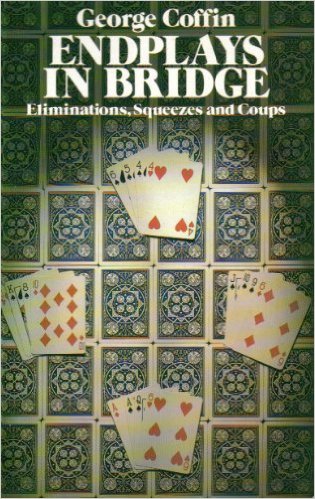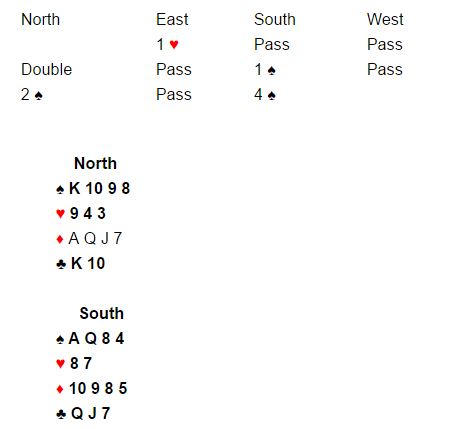
Source: esra-magazine.com 



George Coffin, a 1928 graduate of Harvard and 1931 winner of The Bridge World international problem solving contest, was a co-founder of the American Bridge Teachers’ Association (ABTA).
Author of more than 200 books that included bridge, poker, cribbage and other card games, he was particularly known for his exceptional technique in bridge endplays (eliminations, squeezes and coups) resulting in his nickname «Endplays» Coffin, after his classic books on the subject.
My personal favorite oldie-but-goodie is his “Bridge Play from A to Z”, first published in 1954, in which he classifies declarer play in alphabetic files. In previous articles we have covered hands that fall, for example, under A for Avoidance (keeping the danger hand off lead) and E for Elimination (stripping both hands of side suits as a preliminary to forcing an opponent into giving you a free finesse).
Of Coffin’s “Files”, two – C for Counting and I for Inference – do not deal directly with playing techniques but rather with subordinate factors that help us decide which plays to make.
Unlike in chess, where both players see all 32 pieces and the 64 squares on the board, bridge players see only their own 13 cards and, during play, those of dummy. A picture of the unseen hands must be built using inferences from what has been bid or played, or, often, from what has not been bid or played.
A classic example is the following hand. (I have not shown the defenders’ cards on purpose.)
With East-West vulnerable and East dealer, the bidding proceeded as follows:
West led and won the first trick with the  K. He continued with the
K. He continued with the  J, which East won with the
J, which East won with the  A and played and led the
A and played and led the  Q and played a third heart. Declarer ruffed and West followed with a low heart. Declarer now played a club, losing to East’s Ace, and won the trump return. Declarer drew trumps, East’s J falling on the third round. Declarer’s
Q and played a third heart. Declarer ruffed and West followed with a low heart. Declarer now played a club, losing to East’s Ace, and won the trump return. Declarer drew trumps, East’s J falling on the third round. Declarer’s  Q and
Q and  J won the next two tricks, both opponents following. Now comes the crunch: how to play diamonds?
J won the next two tricks, both opponents following. Now comes the crunch: how to play diamonds?
So far, if you have been counting, East has shown up with 11 points and his remaining 4 cards are 2 hearts (from his original 5) and either 2 diamonds or a diamond and a club. Where is the  K? Most likely with East because of his vulnerable opening bid but not for sure on that score: he may well have chosen to open with
K? Most likely with East because of his vulnerable opening bid but not for sure on that score: he may well have chosen to open with  J x x,
J x x,  A Q 10 x x,
A Q 10 x x,  x,
x,  A x x x. No, the strongest inference comes from West’s failure to raise partner’s opening bid to 2
A x x x. No, the strongest inference comes from West’s failure to raise partner’s opening bid to 2 after South’s pass. He has shown up with
after South’s pass. He has shown up with  K J x, so surely with the
K J x, so surely with the  K as well, he would have supported partner’s opening bid. The
K as well, he would have supported partner’s opening bid. The  K is with East and the only hope is that it’s singleton.
K is with East and the only hope is that it’s singleton.
Declarer played the  A dropping East’s singleton King. East went on to fight the battle but kept his cards closer to his chest.
A dropping East’s singleton King. East went on to fight the battle but kept his cards closer to his chest.
Another hand from a recent advanced teaching session:
After West dealt and opened 1 , North-South reached a game in Spades, with South as declarer.
, North-South reached a game in Spades, with South as declarer.
West led the  A and the
A and the  K, and then switched to
K, and then switched to  J. Declarer won and drew the last trump. She could only afford to lose one more trick. While she was thinking, she played two more rounds of clubs, voiding both hands of that suit. (E for Elimination!) West played the
J. Declarer won and drew the last trump. She could only afford to lose one more trick. While she was thinking, she played two more rounds of clubs, voiding both hands of that suit. (E for Elimination!) West played the  8 and
8 and  9. Placing the
9. Placing the  K with West from the opening bid, she correctly determined that attempting a heart finesse would be pointless and so now played
K with West from the opening bid, she correctly determined that attempting a heart finesse would be pointless and so now played  A and then
A and then  Q, not caring who had the
Q, not caring who had the  K because whoever won had to play diamonds – allowing you to pick up the
K because whoever won had to play diamonds – allowing you to pick up the  Q wherever it was – or give you a ruff and discard by leading hearts or clubs.
Q wherever it was – or give you a ruff and discard by leading hearts or clubs.
Not so. West’s defense was up to scratch. She gave declarer a ruff and discard by playing another round of hearts. She knew by counting that declarer had 4 diamonds, exactly the same distribution as dummy, so the ‘ruff and sluff’ wouldn’t help her. She could only discard one diamond and would still have to guess the diamond position.
Now, from West’s original play of the  J, presumably from
J, presumably from  J10, declarer should have inferred that West still had the last club, the
J10, declarer should have inferred that West still had the last club, the  10. With at least five hearts and four clubs, and two spades, West therefore had at most two diamonds. Rather than play the hearts when she did, declarer should have played the
10. With at least five hearts and four clubs, and two spades, West therefore had at most two diamonds. Rather than play the hearts when she did, declarer should have played the  K from dummy and then the
K from dummy and then the  J. If it was not covered, she could have ducked to West. If West had won with the doubleton
J. If it was not covered, she could have ducked to West. If West had won with the doubleton  Q, would it matter? No! West would only have hearts and a club left, and would have been faced with a Hobson’s choice: a heart return would play into South’s
Q, would it matter? No! West would only have hearts and a club left, and would have been faced with a Hobson’s choice: a heart return would play into South’s  A Q, and a club return would allow her to ruff in either hand and discard a losing heart from the other.
A Q, and a club return would allow her to ruff in either hand and discard a losing heart from the other.


